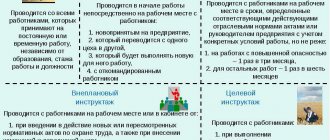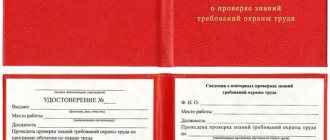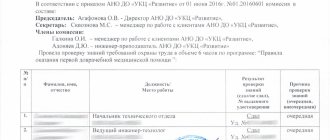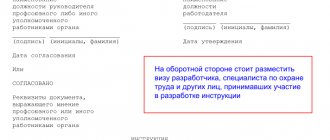What kind of document is the Labor Safety Agreement?
An agreement on labor protection is a legal form for planning and carrying out labor protection measures, indicating deadlines for implementation, sources of financing and those responsible for their implementation.
Since 1995, the Agreement on Labor Safety has been an independent legal document. However, the order of the Ministry of Labor dated March 25, 2013 canceled its legal status. However, the need to regulate the scope of labor protection has not disappeared, and this document has become part of the collective agreement, drawn up as an annex to it. If there is no collective agreement, it is recommended to conclude a labor protection agreement to protect the interests of both the employee and the employer.
General provisions on the collective agreement
General provisions on the collective agreement are contained in Chapter. 7 Labor Code of the Russian Federation. It establishes the official definition of this agreement, what it should look like, the procedure for its development, conclusion, amendment and registration, and also contains answers to other questions that arise on this topic.
Based on Art. 40 of the Labor Code of the Russian Federation, a collective agreement is a legal act regulating relations in the social and labor sphere in a specific organization or with a specific entrepreneur, concluded between the employer and his employees represented by representatives.
This agreement is part of the system of acts containing labor law norms and resolves issues directly related to labor activity in a particular organization. At the same time, the provisions of the collective agreement cannot contradict the Labor Code of the Russian Federation. In case of inconsistency with the TCs, they should not be applied.
The Labor Code of the Russian Federation proposes, among other issues, to regulate labor safety standards in the collective agreement, including certain categories of workers, for example, women, minors, pensioners, etc.
Typically, the regulation of labor protection in a collective agreement comes down to indicating in it:
- what professions and jobs are harmful or dangerous;
- workers of which professions are entitled to claim additional guarantees, benefits and compensation;
- what guarantees, benefits and compensations are provided to such employees, etc.
Specific labor protection measures are listed in a document, which, as a rule, is drawn up as an annex to the collective agreement - a labor protection agreement. If there is no collective agreement in the organization, the agreement is concluded as a separate independent document.
Who develops the Occupational Safety and Health Agreement in the organization?
The development of the agreement and the corresponding section of the collective agreement is organized by the labor protection committee (commission) at the enterprise, institution, or organization.
The committee consists of representatives of the employer and the trade union on a parity basis. Representatives of the employer and elected representatives of the trade union are approved by order of the employer.
The Committee collects information and creates a data bank on the state of labor protection and life safety at an enterprise, institution, or organization.
If the organization does not have a labor protection commission, then the labor protection agreement is developed by a labor protection specialist. If the organization has less than 50 people and the staffing table does not include the position of a labor protection specialist, the function of ensuring labor protection is assumed by the manager or another employee authorized by the order.
How is compliance with the terms of the agreement verified?
Any internal act issued at the enterprise, after it comes into force, must be immediately accepted by an authorized employee, who, for the period of validity of the agreement, is obliged to monitor compliance with its requirements. The list of his actions includes the following important criteria to ensure the necessary checks:
- Delegation of authority to other company employees to comply with all requirements of the agreement.
- Periodic inspection of all technical systems by the engineering staff of the enterprise - fire alarms, signal panels, quality of electrical wiring and other equipment requiring special assessment.
- Each immediate manager of the department must provide instructions before the start of the working day of his team, or a corresponding work permit is drawn up for a particular type of work activity, followed by providing a copy of it to the person responsible for labor protection.
- If necessary, a working commission is created from employees of different departments to check working conditions and compliance with safety regulations during a certain period, most often once every quarter.
Attention! Each employee authorized for his area reports to the person who controls the execution of management’s orders on the results of his work, on the basis of which a general report is generated at the end of the year.
An authorized employee checks the serviceability of the equipment
Main sources of legal regulation Agreement on labor protection
- Constitution of the Russian Federation. It enshrines the employee’s right to work in conditions that meet safety requirements and sanitary and hygienic standards.
- Labor Code of the Russian Federation. The main priorities of the state labor protection policy are identified, the rights and responsibilities of employers and employees to comply with labor protection requirements are explained.
- Federal Law of July 24, 1998 No. 125-FZ “On compulsory social insurance against accidents at work and occupational diseases.” Approved the mandatory nature of insurance against accidents during work, as well as for diseases caused by harmful working conditions.
- Federal Law of March 30, 1999 No. 52 -FZ “On the sanitary and epidemiological welfare of the population.” Obliges the employer to organize regular medical examinations for employees, as well as to ensure the satisfactory condition of the workplace in terms of sanitary standards.
- Order of the Ministry of Health and Social Development of the Russian Federation dated March 1, 2012 N 181n “On approval of the Standard List of measures annually implemented by the employer to improve working conditions and safety and reduce levels of occupational risks.” (Registered with the Ministry of Justice of the Russian Federation on March 19, 2012 N 23513). Recommends that employers have a list of measures to improve working conditions and safety and reduce levels of occupational risks.
What measures should be included in the Occupational Safety and Health Agreement?
Planning of occupational safety measures is aimed at preventing accidents at work, occupational risks and diseases, improving working conditions and safety, sanitary and welfare provision for workers.
Occupational safety measures are formalized by agreement, taking into account proposals from the Rostrudinspektsiya and other federal supervisory authorities, employers, employees in labor relations with employers, and other representative bodies authorized by employees. Proposals are made based on an analysis of the causes of industrial injuries and occupational diseases, based on the results of an examination of the technical condition of production equipment, as well as taking into account work on a special assessment of working conditions.
Based on these data, the committee (commission) develops an agreement on labor protection. Verifies the implementation of the activities of this agreement, the correct use and expenditure of funds specified in the agreement.
Measures to ensure labor protection
When concluding an agreement on labor protection measures, the following measures can be included in it:
| Measures | What may include |
| Organizational | Assessment of the working conditions in which employees of the enterprise perform their duties. It must be performed at least once every 5 years. The required working conditions are described in the agreement on its protection. Qualification testing and training in new knowledge on labor protection. This must be done every year. Drawing up instructions for the safe performance of labor functions at the enterprise. Compiling lists of professions that require additional payments, etc., because they perform work that poses a risk to health and/or life |
| Technical | This includes checking conditions in the workplace. It occurs in accordance with current sanitary standards and safety requirements. |
| Individual protection for each employee in the enterprise | The Occupational Safety and Health Officer must provide each employee with the necessary protection to carry out work safely (if required by law) |
| Fire safety | Drawing up and approval of instructions for employees in the event of a fire in the workplace Checking installed fire alarms, as well as installing and replacing them in case of malfunction. Drawing up evacuation plans Checking for the availability and purchasing of fire extinguishing agents, as well as their installation. |
Also see “Safety in the workplace: instruction and its types.”
Is it necessary to have an Occupational Safety and Health Agreement in an organization?
The State Labor Inspectorate asks for this document during inspections.
In accordance with Article 45 of the Labor Code of the Russian Federation, an agreement is a legal act regulating social and labor relations and establishing general principles for regulating related economic relations, concluded between authorized representatives of workers and employers at the federal, interregional, regional, sectoral (intersectoral) and territorial levels social partnership within their competence. The agreement may include mutual obligations of the parties on the following issues: wages; labor conditions and safety; work and rest schedules and other issues determined by the parties
For quite a long time in Russia, Resolution No. 11 of the Ministry of Labor of the Russian Federation of February 27, 1995 was in force, according to which the employer was recommended to conclude an agreement on labor protection with the organization representing the interests of the employee (most often a trade union). This agreement contained a list of measures aimed at improving labor safety, indicated the timing, cost of their implementation, as well as full name. and positions of employees responsible for the implementation of relevant activities.
Resolution No. 11 was canceled by order of the Ministry of Labor of the Russian Federation dated March 25, 2013 No. 15, and therefore such a legal category as an agreement on labor protection was excluded from the legal field. However, employers still have a practical need to conclude such agreements.
So, in accordance with the amendments to Art. 219 of the Labor Code of the Russian Federation, approved by Law No. 421-FZ of December 28, 2013, every employee working in harmful and dangerous conditions has the right to guarantees and compensation established by the Labor Code, collective agreement, agreement, or local regulations. In addition, in Art. 219 of the Labor Code of the Russian Federation establishes that an employee has the right to a workplace that meets labor protection requirements.
The specifics of providing certain guarantees and compensation to employees are regulated by the provisions of Art. 92, art. 117 and art. 147 Labor Code of the Russian Federation. Each of them states that the employer is obliged to provide employees with established guarantees and compensation in the manner established in the collective agreement, and in some cases in agreements.
Thus, the subjects of the labor protection agreement can be the employer, on the one hand, and the employees, or the organization representing their interests, on the other.
In addition, Order of the Ministry of Health and Social Development of the Russian Federation dated March 1, 2012 N 181n “On approval of the Standard List of measures annually implemented by the employer to improve working conditions and safety and reduce levels of occupational risks,” recommends that employers have a list of measures to improve working conditions and safety and reduce levels of occupational risks .
Order of the Ministry of Health and Social Development of the Russian Federation dated March 1, 2012 No. 181n On approval of the Standard List of measures annually implemented by the employer to improve labor safety conditions and reduce occupational risk levels
If the information was useful, leave comments and share the link to this article on your social networks. Thank you!
More articles:
Industrial accident: actions of the trade union organization
Conducting SOUT: methodological recommendations
Agreement on labor protection in an organization carrying out educational activities: an approximate list of measures - recommendations of the Ministry of Education and Science of Russia
Regulations “On three-stage control over the state of labor protection of an organization”
Occupational Safety and Health Commissioner: forms and work planning
How to register correctly
Many organizations now enter into agreements with labor organizations that define how safe operations will be maintained within the company. To do this, an appropriate agreement must be concluded and signed.
A labor safety agreement is a document containing the entire list of activities that will be observed and implemented in order to maintain safety at the enterprise. In order for a document to have legal force, it must be concluded and executed in the correct order:
- First you need to develop a draft document.
- The draft document can be formed only after collective negotiations take place between the boss or his representative and the workers’ trade union.
- After negotiations, the document must be signed by both parties. Only after this is it considered legal and valid.
In large companies, the agreement is a separate document, which must necessarily contain the following information:
- organization structure;
- list of persons responsible for labor protection;
- procedure for monitoring compliance with requirements;
- listing measures aimed at improving safety;
- resources that are necessary to ensure labor protection.
The document must contain all measures that will be applied to ensure that the work is safe. The need to take certain actions is evidenced by the results of workplace certification. This certification must be carried out in accordance with the requirements of the supervisory authorities.
An obligatory and final stage in drawing up an agreement is the issuance of an appropriate order. When drawing up an order, the manager must be guided by the following rules:
- The text of the order must indicate the validity period of the agreement, which is usually one year.
- The purpose of drawing up the agreement is reflected. This is necessary to improve working conditions in the company, as well as interaction between the trade union body and the organization’s management.
- The text must contain an order that the document is approved. The person who is appointed responsible for its execution is also indicated.
- At the very end of the document there must be signatures of all parties.
- Space must be left to indicate the date of issue of the order.
If the agreement is drawn up as an annex to a collective agreement, then it can be drawn up like this:








